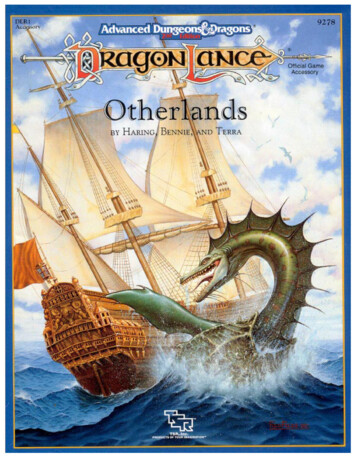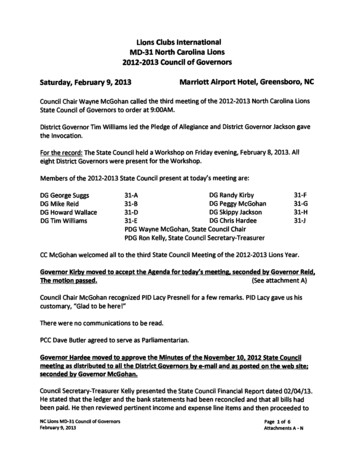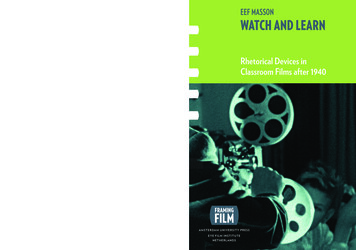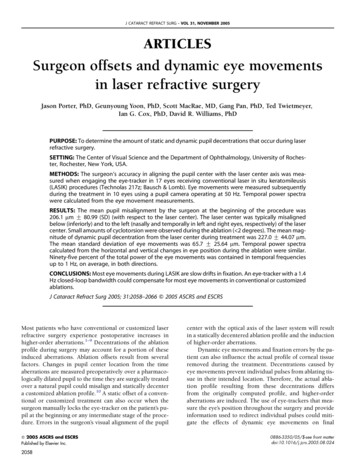
Transcription
OtherlandsBYHARING, BENNIE,TABLEOFCHORANE . . . . . . . . . . . . . . . . . . . . . . . . . 2-32The Land. . . . . . . . . . . . . . . . . . . . . . . . . . . . 2The People . . . . . . . . . . . . . . . . . . . . . . . . . . 7The Ameshites . . . . . . . . . . . . . . . . . . . . . . . 9The Yaluu . . . . . . . . . . . . . . . . . . . . . . . . . . 16The Vodar . . . . . . . . . . . . . . . . . . . . . . . . . . 23Non-Human Races . . . . . . . . . . . . . . . . . . . 25The Monsters of Chorane . . . . . . . . . . . . . . 28F u n n o . . . . . . . . . . . . . . . . . . . . . . . . . . . . . 30R a z h a k . . . . . . . . . . . . . . . . . . . . . . . . . . . . . 31Ursoi . . . . . . . . . . . . . . . . . . . . . . . . . . . . . . 3 2SELASIA . . . . . . . . . . . . . . . . . . . . . . . . . . 33-63Prelude: The Decline of the Irda . . . . . . . . 33Overview . . . . . . . . . . . . . . . . . . . . . . . . . 34The Spine of Taladas . . . . . . . . . . . . . . . . . 35Features of Selasia . . . . . . . . . . . . . . . . . . . . 37The Mischta . . . . . . . . . . . . . . . . . . . . . . . . 39The Bolandi . . . . . . . . . . . . . . . . . . . . . . . . 47Anaiatha . . . . . . . . . . . . . . . . . . . . . . . . . . . 55ANDTERRACONTENTSThe Irdanaiath . . . . . . . . . . . . . . . . . . . . . .Bolandi . . . . . . . . . . . . . . . . . . . . . . . . . . . .Ogre, Mischta . . . . . . . . . . . . . . . . . . . . . . .Ogre, Nzunta . . . . . . . . . . . . . . . . . . . . . . .Spirit, Wisdom . . . . . . . . . . . . . . . . . . . . . .5660616263WATERMERE . . . . . . . . . . . . . . . . . . . . . . 64-96Dargonesti Society . . . . . . . . . . . . . . . . . . . 67Geography and Terrain . . . . . . . . . . . . . . . 69Daily Life . . . . . . . . . . . . . . . . . . . . . . . . . . 72Flora and Fauna . . . . . . . . . . . . . . . . . . . . . 73Dargonesti from Cradle to Grave . . . . . . . 75Religion . . . . . . . . . . . . . . . . . . . . . . . . . . . . 76The Dargonesti Army . . . . . . . . . . . . . . . . . 78M a g i c . . . . . . . . . . . . . . . . . . . . . . . . . . . . 80Relations with Undersea Folk . . . . . . . . . . 83Relations with Surface Folk . . . . . . . . . . . . 90The Mahkwahb. . . . . . . . . . . . . . . . . . . . . . 92Dargonesti as PCs . . . . . . . . . . . . . . . . . . . . 94Dragon, Brine . . . . . . . . . . . . . . . . . . . . . . . 95CREDITS:Design: Scott Bennie, Scott Haring, and John TerraEditing: Mike BreaultCover Art: Fred FieldsInterior Art: David SimonsCartography: Supvr./Designer: Dave SutherlandArtist: Dave Sutherland & Linda GoehreTypography: Angelika LokotzDistributed to the book trade in the United States by Random House, Inc., and in Canada by Random House of Canada, Ltd. Distributed to thetoy and hobby trade by regional distributors. Distributed in the United Kingdom by TSR Ltd.ADVANCED DUNGEONS & DRAGONS, AD&D, DRAGONLANCE, PRODUCTS OF YOUR IMAGINATION, and the TSR logo are trademarks owned by TSR, Inc.This material is protected under the copyright laws of the United States of America. Any reproduction or other unauthorized use of the materialor artwork contained herein is prohibited without the express written permission of TSR, Inc. 1990 TSR, Inc. All Rights Reserved. Printed in the U.S.A.TSR, Inc.POB 756Lake GenevaWI 53147 USAISBN 0-88038-829-39278XXX1501
CHORANETHE LANDOFAMESH Sing out all you people,Of that long-ago dayWhen Amesh the Brave OneLed our fathers away The land had grown harsh,And our enemies strong;Soon none would be leftTo sing our tribe s song.Amesh the Brave One,He rode out alone.He swore he would findHis people a home. Sing out all you people,Of that long-ago dayWhen Amesh the Brave OneLed our fathers away. In a year and a dayBrave Amesh returned.He told of a landhe called Ice That Burns. South they all traveled,And then south some more,Over the Ice Walland through Amesh s Door. Sing out all you people,Of that long-ago dayWhen Amesh the Brave OneLed our fathers away Twas a hard trip and long,And many were lost,But for a new home and freedom,It was well worth the cost.Down into the ice,In molten rock domes,Amesh led his peopleTo this, our new home. Sing out all you people,Of that long-ago dayWhen Amesh the Brave OneLed our fathers away Excerpt fromSong of Amesh,AnonymousTo many people on Krynn, Chorane isa myth. Everyone knows that nothingcould possibly live in the frozen wastesbeyond the Ice Wall south of Ansalon;Chorane is a romantic notion, to be sure,but with no basis in reality.Right.Those who dismiss the possibility oflife or even more unlikely civilizationbeneath the southern ice cap of Krynn donot adequately understand the geologyof this very unusual planet. Nor do theytake into account the ability of Krynn svarious inhabitants to endure great hardship and to adapt to nearly any environment. For not only is there life beneaththe ice, but in Chorane there is a complexcivilization of many different intelligentraces, interacting in all sorts of peaceful(and not-so-peaceful) ways.THE LANDIt is a long, dangerous trek acrossnearly a thousand miles of frozen groundand sheets of ice before any sign ofChorane can be found. And even thatsign shows no outward evidence of beingthe gateway to a vast underground civilization; it is a 175-foot-wide crevasse inthe tundra that is nearly half a mile longand seemingly bottomless. Rising fromthe crevasse is a constant flow of steamthat warms the area along both sides for adozen or so yards from each edge.Growing along the lip of the crevasseand down along the sides for as far as theeye can see are all sorts of fungi, clingingvines, small flowering plants, and eventhe occasional gnarled tree. The edge ofthe crevasse is very slippery because of thefungi and the constant condensationfrom the steam; many explorers have approached the edge too enthusiasticallyand fallen to their deaths just as they wereon the brink of their greatest discovery.GEOGRAPHYActually, Amesh s Rent (as it is calledby the Ameshites), or The Crack (as it iscalled by the other peoples of Chorane),is not the only way to get to Chorane.There are at least 17 other, smaller cre2vasses that are known to lead to the vastunderground caverns and tunnels thatmake up this land (see the map on page3). Other than Amesh s Rent, however,there are only two other frequently-usedentrances: The Little Crack and ThreeMile Gorge (see map). Of the other 15,five are too dangerous or connect with areas of Chorane that are too remote to beuseful. The other ten are Dragonholes.With only minor variations, all theDragonholes are the same perfectlyround, perfectly smooth holes anywherefrom 30 to 50 feet in diameter, headedstraight down with only a hint of a spiralfor over two miles. Eventually, the Dragonholes veer sideways into various labyrinthine passages that lead to hugeunderground lairs and (it is rumored) vasttreasure chambers. No one has ever returned with any of this treasure, however.In fact, very few people who explore theDragonholes have ever come back at all.(For more on dragons in Chorane, seePage 29).The Crack is over 7,000 feet deep, andit leads down to a lake of crusted-overmolten rock. This lake, and several otherexposed lava flows, provide the heat andsteam necessary for life in Chorane. Starting at just over 500 feet down, a series oftunnels, fissures, and caves opens outinto Amesh s Rent, providing a surprising amount of space. Once you get anysignificant distance away from TheCrack, however, caves this near the surface are far too cold to live in. And ofcourse, the opposite problem exists if youget too close to the molten lake. The various peoples of Chorane, therefore, all livebetween 2,000 feet and 3,400 feet belowthe surface of the ice.There are five different groups of people, including three tribes of humans,living in Chorane. Four of the five groupslive in their own distinct areas ofChorane, as shown on the map on pages4-5.Most of the caverns, chambers, andtunnels in Chorane were formed naturally early in the history of Krynn. Only avery few of the areas have been carved outby the inhabitants. Earthquakes, lavaflows, and other seismic upsets are fortu-
3
4
5
CHORANEnately very rare, but they tend to be verydevastating when they do occur. The lastrecorded serious earthquake in Choranewas 133 years ago.TERRAINWhen Chorane was formed long ago,it was a land of rock and ice. Since then,however, millennia of steam, volcanicheat, and hardy plants gaining tenuousfootholds have worked on the rock whereit meets the warm, humid air, forming ashallow (three inch or so) layer of dirt inmany places. Until magic-using creaturesfound Chorane, of course, it was too darkfor plants to grow (except for certain typesof fungus) anywhere but very close to direct passages to the surface, so in thedarker recesses of Chorane that is, mostof it the surface is still solid rock. SinceAmesh and his followers found their buried refuge some 700 years ago, however,their use of magical light spells and itemshas greatly extended the areas in whichfungus and plants can be grown. As a result, more and more rocky surfaces are being broken up. In some areas, almost oneinch of topsoil has developed.What is not rock in Chorane is ice.There are many chambers and corridorsin this underground kingdom that aremade entirely of ice, but very few peopleinhabit them except out of necessity. Afire or other source of heat can be built ina rock chamber; the effects in one of icecan be very, well, wet. In some places, iceruns in veins through the rock. This typeof formation is rare and much prized bythe Choranians, as it provides an easilyaccessible source of water.Getting around in Chorane is fairlyeasy, if you stay within one tribe s area.(Moving from one tribe s area to anotherhas perils all its own, as will be explainedlater.) The caverns and large chambers areall connected by a crazy quilt of tunnels,slides, and corridors; there are usually atleast three perfectly good ways to getfrom one place to another. One of theleading pastimes among Choranians, infact, is arguing over which of the manyavailable routes between two places is actually the best.Getting around in Chorane is more of athree-dimensional exercise than it is onthe surface. With 1,400 feet or so separating the highest and lowest habitable areas, getting up and down is just asimportant as getting back and forth. Byusing Chorane s many natural slopingpassageways and stairways that have beencut into the steeper tunnels, it is possibleto walk to any elevation in the area eventually. To get any great distance up ordown quickly, however, takes othermeans.There are over a dozen nearly verticalshafts traversing the entire height ofChorane, including one over 40 feetacross. These are of very great strategicimportance to the various tribes, so theseare very difficult to use without someonenoticing. Several of the shafts have handand footholds for climbing, while othershave had climbing ropes and ladders(made of rope, leather thongs, and curedfunno hides) built in them. One shaft,controlled by the Yaluu, has a crudeelevator-type contraption in it for theconvenience of the ruling elite; it is powered by slave labor.All Choranians are accomplishedclimbers and mountaineers (though theydo not use the word mountaineer infact, they have no idea at all what amountain is) practically from birth. In apinch, one could climb the wall ofAmesh s Rent all the way to the surfaceand make it look as easy as walking. Accidents still happen, of course, but a newcomer to Chorane would find itimpossible to safely move around at evena fraction of the speed of the natives.C LIMATESeasonal variations are nearly nonexistent in Chorane at 2,000 feet below thesurface, it s hard to tell even the difference between day and night. Temperatures, along with most other climacticconditions, remain constant year round.At the top of Chorane, closest to the surface, temperatures stay near 45 degrees,while at the bottom it is a more comfortable 65 degrees or so. It is colder fartherup, of course (the temperature on the sur-6face is above freezing only during the dayin the summer), and much hotter as youapproach the lava lake at the bottom ofAmesh s Rent.Choranians have not moved any farther down than the 3,400-foot level because there are few habitable caverns inthe next 500 to 1,000 feet. Below that,there are more good locations, but thetemperatures are well in excess of 140 Fahrenheit. Hunting parties occasionallyventure into these hotter areas to huntanimals and to harvest rare plants andfungi, but it is a dangerous foray that isnot to be taken casually.As you move away from the steamvents (at any level), the temperaturesdrop dramatically. Only a few hundredfeet from any of the major vents, the temperature drops 15 to 20 degrees fromwhat is normal for that depth.Humidity is very high throughoutChorane, and this is a good thing; thesteam rising from the lava flows far belowcondenses on the cool ice and rock wallsand forms the foundation of the entirefood chain down here.The wind blows constantly in Chorane.It rushes up the major vents toward thesurface, drawing air through the corridorsand caverns of the land as it goes. Thewind patterns are very well known by thenatives, but they may take newcomers bysurprise; it would not be unusual to stepout of a small cave with hardly any windinto a cross corridor with a wind strongenough to knock an unaware man to theground.
THE PEOPLETHE PEOPLEIn The Song of Amesh, the song cyclethat tells of the history of the Ameshitepeople, it says that when Amesh broughthis people to Chorane, at first they metno other peoples, and they thought theentire of Chorane was uninhabited, except for various wild animals and the occasional monster. This did not turn out tobe entirely true.The first people the Ameshites metwere the Kendar (as they called themselves), a lost offshoot of the kender racethat still spoke an obscure dialect relatedto the kender tongue. The same size andgeneral appearance of kender, the Kendar share their cousins great curiosityand carefree attitudes, though they arequieter and less demonstrative than theirsurface-dwelling cousins.It was only a few score years later thatfirst contact was made with the Theiwar, arace of dwarves that had not seen the surface in several millennia. It was not (andstill is not) known whether these Theiwarhad always lived in a remote section ofChorane, or had just discovered it afterextensive underground exploration fromsome other part of Krynn.While the Ameshites got along with theKendar much better than they did withthe Theiwar (the latter being very possessive of their own holdings and somewhatcovetous of everybody else s), there was little cause for strife both the Theiwar andthe Ameshites were busy exploring and expanding their territories, and the Kendarweren t interested in warfare. It was onlyafter the Great Rift that affairs degenerated into their current state.The Great Rift was a direct result of theCataclysm that struck Krynn some 300years ago. While not as devastated asmany other parts of Krynn, Chorane wasseverely damaged by the Cataclysm. Entire caverns were collapsed or cut off,while new passages and living areasopened up. There was no place to hideduring the Cataclysm and its many aftershocks. Thousands of Choranians died,and thousands more were never seenagain and were presumed dead.7It was during the clean-up and repairprocess that the first rumblings of whatwould become the Great Rift were felt.One group of Choranians felt that theCataclysm was proof that the people hadturned away from the gods. They felt thatthe solution was to rededicate themselvesto the old rituals and beliefs that Ameshbrought with him from Ansalon. Thesepeople became known as Ameshites. Another group believed the exactopposite that the Cataclysm was proofthat the gods had turned away from thepeople, and that the solution was to findnew gods. They ridiculed the Ameshitesfor their tired, old beliefs, and calledthemselves the Yaluu, which is theChoranian word for seekers. And there was a third group of Choranians with yet another set of beliefs, the Vodar. The Vodar were most interestedin keeping all the humans of Chorane together, emphasizing their common background and heritage. The Vodar sought acompromise between the Ameshites andthe Yaluu, suggesting that some of theold traditions and rituals be maintained
THE PEOPLEwhile new answers were also sought.Extremists in both camps ignored theVodar s offer of reconciliation, eachgroup accusing the Vodar of being inleague with the other. It did not takelong, in the enclosed spaces of Choraneand under the great stress of recent disasters, for the philosophical disagreementsbetween the peoples of Chorane to escalate into violence and bloodshed.Fueled by constant feuding and skirmishing over the past 300 years, the tensions between the three human factionsof Chorane are as high as ever. An uneasytruce exists between the Ameshites andthe Yaluu, though either group would eagerly exploit any opportunity for gain.The Vodar continue to be stuck in themiddle, mistrusted and disliked by bothsides.While this hatred is more intense thanever, its nature has changed. The reasonsfor the dispute have been forgotten bymany; while the government and religious leaders remember, most of the people hate the other side simply because it s8the way things have always been. In manyof the stories and oral histories of theAmeshites and Yaluu, new and more heinous charges than simple religiousunorthodoxy cannibalism, genocide,and much worse have crept in. Most ofthem are not true (though one can neverbe sure about the Yaluu) and are repeatedsolely for their propaganda value.What follows is an outline of each ofthe five major humanoid races living inChorane. This is common knowledge, forplayers and DM alike.
T HE A MESHITESTHE AMESHITESWhile all three human tribes ofChorane are descended from the legendary Amesh and the people he broughtwith him from southern Ansalon, it is theAmeshites who follow Amesh s teachingsthe most scrupulously. The Ameshitesconsider themselves the true followers of Amesh; the Yaluu and the Vodar areheretics and blasphemers, traitors to thememory of their common ancestors.This attitude does nothing to make theAmeshites popular with the other twoChoranian tribes; indeed, relations between the Ameshites and the Yaluu andthe Vodar are downright hostile. TheAmeshites believe they are on a holy crusade to return the fallen tribes to the trueway of Amesh, or failing that, to rootthem out of every last hole in Chorane.Like all descendants of Amesh s tribe,the Ameshites are small of build andrarely over 5 5) tall. Nearly all Ameshiteshave dark hair; blondes (and especiallyredheads) are very rare and are treatedwith both great suspicion and great fascination. The men develop heavy beards ata very young age, and very few go to thetrouble to shave. After 700 years or so inthe caverns of Chorane, the Ameshiteshave also developed very pale skin andenlarged and sensitive eyes, both as a result of the lack of natural light.There are just over 17,000 Ameshitesliving in Chorane. They control nearly allof inhabited Chorane at the highestlevels, but their territory extends no lowerthan 2,600 feet down or so (see map,page 4). They have boundaries with theirallies the Kendar, as well as with the Vodar. While the border between Ameshiteand Kendar territory is free and open (infact, there is a zone on either side of theborder where the two peoples are thoroughly mixed together), all crossingpoints from Ameshite lands into Vodarlands are heavily guarded by Ameshite(and Vodar) troops.G OVERNMENTThe Ameshite government is a theocracy; that is, the government is run bythe religious leaders. The Ameshite religion does not worship Amesh, thoughthe tribal leader who brought them toChorane some 700 years ago has been elevated to a demi-god status in the hearts ofmany Ameshites. The Ameshites worshipPaladine, though that is not what theycall him. In Chorane, Paladine is knownas Parthenu, The First Singer. Parthenu ismost frequently depicted as a tall, perfectAmeshite young man, clad in religiousvestments and strumming a lute. Otherpopular icons of Parthenu show him playing several other instruments, includingflute, trumpet, drum, harp, lyre, triangle, and recorder.Music, especially singing, is the backbone of Ameshite religious life and, to agreat extent, their entire society and culture. The Ameshites have a song for everyoccasion, and many more songs for no special occasion at all. Every important eventin Ameshite life marriages, funerals,government meetings, elections, religiousceremonies, business negotiations, betrothals, trials, and a host of other meetings is accompanied by singing.The leader of the Ameshites is known asthe Prime Singer; he or she (about half ofthe previous leaders have been women)rules for life. Each Prime Singer is chosenfrom among the ranks of the Second Singers, a select circle of a dozen or so leaders ofthe Ameshite people. There is no set number to the size of the Second Circle (as it isknown); there have been as many as 35Second Singers and as few as four. The current makeup of 11-14 has endured fornearly 100 years, more out of tradition andconvenience than anything else.The Prime Singer and the Second Circle share power in their part of Chorane.Since the Prime Singer rose from theranks of the Second Circle, he or she isprobably good friends with most of itsmembers; if relations become unbearablystrained, the Second Circle may replacethe Prime Singer, but only by a unanimous vote. A wise Prime Singer insures along reign by delegating power and authority to many members of the SecondCircle. Each major aspect of the Ameshitegovernment taxes, defense, food production, education, religious ceremo9nies, records, and musical training,among others is under the direct control of a Second Singer.Below the Second Circle is the Chorus,the priesthood of the Ameshites. Members of the Chorus are known as Singers;that honorific is used the same way othercultures use Reverend or Minister. There are anywhere from 250 to 500 Singers among the Ameshites at any time;they are the ones who get the government s work done. The Singers collect thetaxes, manage the farms, teach the children, perform the religious ceremonies,lead the skirmishers, write the chronicles,compose the songs, and tend to the people of Chorane.Becoming a Singer is not easy. Manymore want admission to this elite groupthan obtain it. Twice a year, the SecondCircle announces that new Singers will beadded. Any promising citizens who havebeen recommended by other Singers areinvited to apply. Ameshites who are notspecifically invited may still ask for consideration, but their chances are not as good.The applicants are all interviewed bySecond Singers sometimes just one,sometimes the entire Circle, dependingon how may applicants there are and howbig the Circle is. After the interviewscomes the Festival.The Festival is part celebration, partconcert, and part audition. All applicantsfor the Chorus perform before the assembled Ameshites in the Great Hall, singing before the multitude. As manypeople as can get away from their otherduties attend the Festival, which is one ofthe highlights of Ameshite social life.Most applicants perform traditionalAmeshite songs, though many sing original compositions. While the Second Circle has final say as to who is accepted, thereaction of the audience to the individualperformances is an important factor.There is no quota for how many applicants are admitted into the Chorus; allqualified applicants (in the Second Circle s opinion) are accepted. After someFestivals, no applicants have been admitted; after others, particularly after fiercefighting with the Yaluu when the ranks ofthe Chorus have been depleted, all of the
THE AMESHITESapplicants have become Singers. Thestandards have been known to shift in accordance to the need for additionalSingers.As followers of an aspect of Paladine,one would think the Ameshites follow aphilosophy that would classify them asLawful Good. Certainly, though theAmeshites do not use such words, theybelieve their worship of Parthenu is goodand pure, a true following of the mainforce for Good in Krynn. They re wrong.Take 700 years of isolation, throw inthe Cataclysm (which they weren t eventhe target of), add 300 years of civil war,and it s fairly easy to see how the Ameshites devotion to Parthenu could haveslowly twisted into something other thanwhat Paladine would care for.The Ameshites are still, for the mostpart, good people. They treat each otherwith respect and consideration, and theyconsider fairness and honesty to be important virtues to be cultivated and promoted. It is in their dealings with theother peoples of Chorane where theyhave fallen from Paladine s teachings.The Ameshites are a paranoid people,distrustful of and hostile to anyone theyconsider different. Their alliance withthe Kendar is an uneasy one, though eventhe most bigoted Ameshites know theyneed the Kendar in order to survive, sotensions are kept to a minimum.The Ameshites reserve their greatesthatred for the Yaluu, though the Vodarare not all that far behind. While it is truethe Yaluu have developed some nastyhabits in the 300 years since they splitfrom the Ameshites (more on the Yaluuwill follow), this constant war has beenmostly the Ameshites idea.The Ameshite military, like most fighting units in Chorane, emphasizes speedover size. Most of the fighting betweenthe various peoples takes place in narrowcorridors and choke points between different areas; what good are 200 fighterswhen only five of them can fight at atime?Instead, the reliance is on quickness ofresponse and tactical maneuvering. Thecornerstone of the Ameshite army is thetenner, a unit of ten men, consisting ofone sergeant and five foot soldiers, allwith short swords and shields, two spearmen, and two missile specialists, armedwith either short bows, light crossbows,or slings, depending on the circumstances. The spear men and missile menalso carry short swords, but they do nothave shields.All soldiers wear armor made of curedfunno hides, which are particularlystrong and effective while most hide armors are AC 6, funno armor is AC 5. Afunno-hide shield reduces the armor classof the wearer to AC 4.Standard tenner tactics call for theswordsmen to block a corridor from edgeto edge, while the spear men and missilemen launch attacks from the second rank.The sergeant and any remaining swordsmen stand ready to fill gaps in the frontline. Tenners drill rigorously so that theycan move through narrow corridors, slipthrough crevices, climb steam vents, andmove through the other types of Choranian terrain quickly and silently whilestaying together as a unit.Large-scale warfare is difficult in thenarrow, winding pathways of Chorane.Instead, fighting is of the hit-and-run variety, with tenners (and similar units fromthe other peoples) moving swiftlythrough remote side passages, trying tooutflank, surround, and outnumber enemy units. Territorial conquest is very difficult, because the defender, knowing theins and outs of his home territories, has atremendous tactical advantage. This isthe main reason fighting between theChoranians has gone on for 300 yearswith no end in sight.Wizards, priests, thieves, and otherspecialists are not regularly attached tospecific Ameshite military units, thougha sergeant or officer can request one for aparticular mission. Approval for such anassignment must come from one of theMadrigal, the group of eight Singers thatruns the Ameshite military. Each memberof the Madrigal commands 12 to 15 tenners. At least one of the members of theMadrigal is always of Second Circle rank;in times of great trouble, more than onebelongs to the Second circle.10E CONOMYChorane is not the most hospitable oflands; nearly all of the people s time isspent gathering food, making clothesand shelter, and taking care of the otherbasics of survival.All the Ameshites work, even the children, though all children between theages of 6 and 12 get two hours of formalschooling per day. The schooling is run(like everything else) by the Ameshitechurch, and it emphasizes the basics: reading, writing, simple math, and music.Only students who show promise continuetheir schooling beyond the age of 12.There is very little sex discriminationamong the Ameshites. The military ispredominantly male, but other thanthat, women and men are found in almost equal numbers in all jobs. The mostimportant of these is producing food.The agriculture of the Ameshites, likethat of the rest of the Choranians, isbased on a surprisingly wide variety offungi that can be found throughout theland. Some are harvested from cave walls,floors, and ceilings, where they havegrown naturally for thousands of years.Others, including some new varieties andstrains developed by experimentation,are cultivated like any other crop.Most of the different varieties of fungi(including mushrooms) were developedfor culinary reasons there have to besome changes in the color, flavor and texture of what you re eating, or morale andgeneral mental health suffers. Others ofthe plant life of Chorane has special properties that deserve further mention. Theyare the following:Panisil: This fungus is light green andfuzzy. It grows to a depth of about oneinch on any moist surface. When eaten insufficient quantities (at least half a cup orso), it may cure disease as per the priestspell of the same name. This is not a surething; there is a base 30% chance thepanisil is effective. That percentage can bemodified by the DM according to circumstances, such as the severity of the disease,how far advanced the disease is, the Constitution of the person, and other suchthings. If panisil proves to be ineffective,
11
T HE A MESHITESthe patient cannot try again, though if herecovered and later
ADVANCED DUNGEONS & DRAGONS, AD&D, DRAGONLANCE, PRODUCTS OF YOUR IMAGINATION, and the TSR logo are trade-marks owned by TSR, Inc. This material is protected under the copyright laws of the United States of America. A










